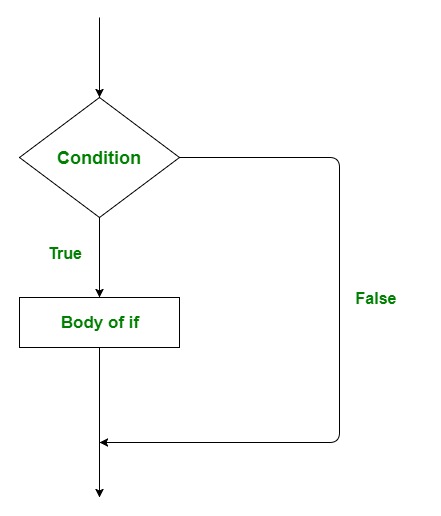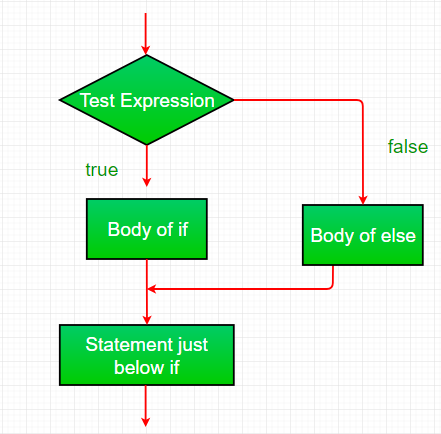R If Else Conditions
Last Updated :
19 Dec, 2023
The if-statement in Programming Language alone tells us that if a condition is true it will execute a block of statements and if the condition is false it won’t. But what if we want to do something else if the condition is false? Here comes the R Programming Language else statement. We can use the else statement with the if statement to execute a block of code when the condition is false.
Syntax of if-else statement in R Language
if (condition) {
# code to be executed if condition is TRUE
} else {
# code to be executed if condition is FALSE
}

if-else statement in R
Working of if-else statements in R Programming
- Control falls into the if block.
- The flow jumps to Condition.
- Condition is tested.
- If the Condition yields true, goto Step 4.
- If the Condition yields false, goto Step 5.
- The if-block or the body inside the if is executed.
- The else block or the body inside the else is executed.
- Flow exits the if-else block.
Flowchart if-else statement in R

R – if-else statement
Conditions and If Statements
Here we will show the use of logical conditions in if statements. Adjust the values and conditions as needed for our specific requirements.
| Equal |
== |
x == y |
| Not equal |
!= |
x != y |
| Greater than |
> |
a > b |
| Less than |
< |
x < y |
| Greater than or equal to |
>= |
x >= y |
| Less than or equal to |
<= |
x <= y |
Ifelse Function in R Programming
R
x <- 5
if(x > 10)
{
print(paste(x, "is greater than 10"))
} else
{
print(paste(x, "is less than 10"))
}
|
Output
[1] "5 is less than 10"
Here in the above code, Firstly, x is initialized to 5, then the if-condition is checked(x > 10), and it yields false. Flow enters the else block and prints the statement “5 is less than 10”.
Ifelse Function in R Programming
R
x <- 5
if(x == 10)
{
print(paste(x, "is equal to 10"))
} else
{
print(paste(x, "is not equal to 10"))
}
|
Output
[1] "5 is not equal to 10"
Nested if-else statement in R
The if-else statements in R can be nested together to form a group of statements and evaluate expressions based on the conditions one by one, beginning from the outer condition to the inner one by one respectively. An if-else statement within another if-else statement in R better justifies the definition.
Syntax
if(condition1){
# execute only if condition 1 satisfies
if(condition 2){
# execute if both condition 1 and 2 satisfy
}
}else{
}
Ifelse Function in R Programming
R
x <- 15
if (x < 10) {
print("x is less than 10")
} else {
if (x < 20) {
print("x is between 10 and 20")
} else {
print("x is greater than or equal to 20")
}
}
|
Output
[1] "x is between 10 and 20"
- In this example, we first define a variable x with the value of 15.
- Then we use a nested if-else statement to check the value of x.
- The outer if-else statement checks if x is less than 10. If it is, we print the message “x is less than 10”. If x is not less than 10, we move on to the nested if-else statement inside the else block.
- This nested if-else statement checks if x is less than 20. If it is, we print the message “x is between 10 and 20”. If x is not less than 20, we print the message “x is greater than or equal to 20”. Since x is 15, the code will print “x is between 10 and 20”.
Ifelse Function in R Programming
R
grades <- 85
income <- 25000
if (grades >= 80) {
if (income <= 30000) {
print("Congratulations, you are eligible for a scholarship!")
} else {
print("Sorry, your income is too high to qualify for a scholarship.")
}
} else {
print("Sorry, your grades are too low to qualify for a scholarship.")
}
|
Output
[1] "Congratulations, you are eligible for a scholarship!"
- In this example, we first define two variables, grades and income, to represent a student’s grades and income, respectively.
- Then we use a nested if-else statement to check if the student is eligible for a scholarship.
- The outer if-else statement checks if the student’s grades are 80 or above. If they are, we move on to the nested if-else statement inside the if block. This nested if-else statement checks if the student’s income is 30,000 or less.
- If it is, we print the message “Congratulations, you are eligible for a scholarship!” If the student’s income is more than 30,000, we print the message “Sorry, your income is too high to qualify for a scholarship.” If the student’s grades are below 80, we print the message “Sorry, your grades are too low to qualify for a scholarship.”
- This nested if-else statement can be expanded upon to include additional conditions, such as residency or enrollment status, to determine scholarship eligibility.
Like Article
Suggest improvement
Share your thoughts in the comments
Please Login to comment...